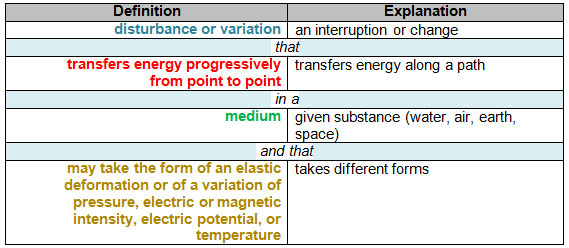

![]() Watch the following videos. See if you can identify what the videos have in common.
Watch the following videos. See if you can identify what the videos have in common.
Source: Waves on a Pier, secretlondon, Wikimedia Commons
![]()
Source: Mexican Wave @ Wembley Stadium - London Olympics 2012, hutchingzz, YouTube
What do the videos have in common?
Physics can be defined as the study of the nature and properties of matter, energy, motion, and force. The videos you watched are examples of waves.
Click on Interactive popup. Assistance may be required. to see how Webster's Dictionary defines it.
a disturbance or variation that transfers energy progressively from point to point in a medium and that may take the form of an elastic deformation or of a variation of pressure, electric or magnetic intensity, electric potential, or temperature
Let's break down the definition and look at its applications.

![]() The video below will provide you background information about waves. Answer the questions below in your notes. (Note: you only need to watch until 9:17. You will watch more of this video in later sections of this resource.)
The video below will provide you background information about waves. Answer the questions below in your notes. (Note: you only need to watch until 9:17. You will watch more of this video in later sections of this resource.)
Source: Waves Introduction, topiicoaching, YouTube
Interactive popup. Assistance may be required.
Wave motion is the movement of energy from one location to another without bulk transfer of matter.
Interactive popup. Assistance may be required.
This means that the particles of matter impacted by the wave do not move from their relative positions.
Interactive popup. Assistance may be required.
Matter is not transferred. Wave motion is a form of energy movement; therefore only energy is transferred, not matter.
Interactive popup. Assistance may be required.
Two types of waves are mechanical and electro-magnetic (non-mechanical). Sound is an example of mechanical waves. Jeat is an example of electro-magnetic waves.
Interactive popup. Assistance may be required.
The audience creates a wave, and each person acts as a particle. The particles remain in the same seat, but the wave moves through the crowd similar to the movement of energy in a wave.
Interactive popup. Assistance may be required.
At this time, create your own definition. We will be looking at this property in later sections of the resource.
Interactive popup. Assistance may be required.
At this time, create your own definition. We will be looking at this property in later sections of the resource.
Waves are special because they carry energy from one place to another without carrying mass with it. The matter through which a wave moves is called the medium, and the molecules of the medium return to their original position after the wave passes by.
In order to understand the motion of waves through different substances, let’s first look at the parts of a wave.
An observer, carefully watching point "P" as the wave moves by, would note that the point rose to a maximum height at the crest of the wave and fell to a maximum depth at the trough of the same wave. After the wave passes, the point returns to the equilibrium position. If another wave passes the observer, the process will repeat itself. This type of repetitive back-and-forth motion is called oscillatory. You will explore more about oscillatory motion in the next section.